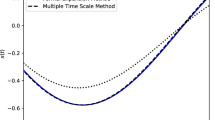Abstract
Complex systems whose subsystems interact at finitely many points are considered. The couplings are given by linear homogeneous differential relations.
The problem of determining the coupling parameters is solved. To this end, the system oscillations are represented as linear combinations of harmonic responses of the subsystems. For each point of coupling, one can construct a system of linear algebraic equations for the parameters (rigidities) of this coupling.
The method is intended for determining the values of rigidities of the couplings between blocks of spacecraft carriers. The analytic model of a simplest structure is carried out as an example.
Similar content being viewed by others
References
V. N. Grishin and V. V. Kirenkov, “Solution of a Typical Inverse Problem in Tests of Rocket Space Technology Products,” Kosmonavtika Raketostr., No. 3 (60), 148–157 (2010).
A. N. Tikhonov, “On the Solution of Ill-Posed Problems and the Method of Regularization,” Dokl.Akad.Nauk SSSR 151 (3), 501–504 (1963) [Sov.Math. Dokl. (Engl. Transl.) 4, 1035–1038 (1963)].
L. D. Akulenko and S. V. Nesterov, “Oscillations of Interacting Systems with Inhomogeneous Distributed Parameters,” Izv. Akad. Nauk.Mekh. Tverd. Tela, No. 2, 15–25 (1999) [Mech. Solids (Engl. Transl.)].
V. N. Voronkov, “A Method for Solving Eigenvalue Problems for Complex Linear Systems,” Izv. Akad. Nauk. Mekh. Tverd. Tela,No. 4, 178–187 (2005) [Mech. Solids (Engl. Transl.) 40 (4), 141–148 (2005)].
V. N. Voronkov, “On aMethod for Solving Eigenvalue Problems for Systems ofOne-Dimensional Subsystems with Discrete Constraints,” Zh. Vych. Mat. Mat. Fiz. 52 (8), 1437–1456 (2012).
L. D. Akulenko and S. V. Nesterov, “Accelerated Convergence Method for Solving the Periodic Boundary Value Problem,” Izv. Akad. Nauk. Mekh. Tverd. Tela, No. 4, 56–68 (1999) [Mech. Solids (Engl. Transl.)].
V. A. Postnov, “Use of Tikhonov’s Regularization Method for Solving Identification Problem for Elastic Systems,” Izv. Akad. Nauk. Mekh. Tverd. Tela, No. 1, 64–71 (2010) [Mech. Solids (Engl. Transl.) 45 (1), 51–56 (2010)].
Author information
Authors and Affiliations
Corresponding author
Additional information
Original Russian Text © V.N. Voronkov, 2016, published in Izvestiya Akademii Nauk, Mekhanika Tverdogo Tela, 2016, No. 2, pp. 100–108.
About this article
Cite this article
Voronkov, V.N. Method for determining the coupling parameters for complex linear systems with discrete couplings between subsystems. Mech. Solids 51, 216–222 (2016). https://doi.org/10.3103/S0025654416020096
Received:
Published:
Issue Date:
DOI: https://doi.org/10.3103/S0025654416020096




